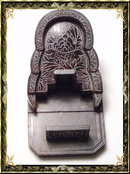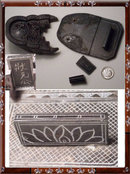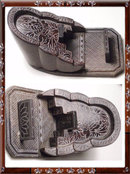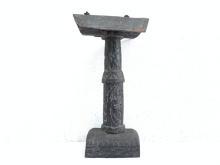ANtique Chinese sarcophagus Grand TOur Coffin




$699.00
This is an antique mechanical miniature of an honored and revered Chinese individual who was very high in the ranking system of the Chinese culture. I believe this is a grand tour chamber crypt that would have been given with the utmost respect and honor to whomever received it. What you dont know about this piece is that the translation for the inscription on the removable panel on the front it is champion Scholar, a person of high rank and honor, and in the Asian culture that person would have been ranked almost as high as the Imperial family . Not only is this a most unusual piece but it is also one that has was hand carved of onyx or bone and inside is a very tiny coffin that slides out when you open the panel at the front. That scholars have long held a place of honor and authority in China is well known. The practice of appointing men to office on the basis of preliminary academic qualifications can be traced back for over 2000 years. How this came about was when the Chinese imperial examination system ( a method to evaluate ability and select officials in dynastic China on the basis of merit rather than social position or political connections) would evaluate scholars and people with vast knowledge. The origin of the system can be traced back to the Han Dynasty (206 B.C.-220).From the Tang Dynasty to the Qing Dynasty. The Chinese imperial examinations attracted many foreign candidates, who not only passed related exams but also were granted official titles and positions. .This puzzle-like stone mausoleum has the lotus flower on the top and front panel. The Lotus flower has for thousands of years symbolized spiritual enlightenment. In Egyptian myths, the Sun-god was reborn each day of a huge Lotus blossom which grew in Nun, the Primordial Sea from which arose all life, including the gods. Egyptian tomb inscriptions expressed the desire of the dead to possess immortality like the Sun-god, they too would rise each day from the Underworld, via the great Lotus to enjoy eternal life. Often the occupant of the tomb is shown seated holding a Lotus blossom near his nose smelling its life-giving aroma. The Lotus, also known as the sea rose, is unique and important because of its close association with Buddhism. The Lotus is one of the eight precious things of Buddhism. This is why the Buddha sits on a lotus in bloom. Another little known fact is that a lotus blossom decoration is found only on Chinese coffins . The culture of building huge tomb mounds spread from the Kinai area to other parts of the country, and by the early fourth century kofun took on a greater variety of forms-some square, some gourd-shaped, were being built in northern Kyushu. But it was in the fifth century that they underwent their most drastic change, with a corridor leading to the burial chamber, giving rise to the culture of family tombs. This piece is in great condition and the only thing it needs is a new wooden dowel to keep the top firmly attached ( one dowel is present)




